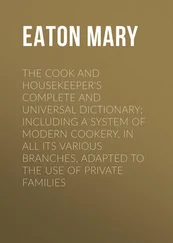Mary Randolph - The Virginia Housewife
Здесь есть возможность читать онлайн «Mary Randolph - The Virginia Housewife» — ознакомительный отрывок электронной книги совершенно бесплатно, а после прочтения отрывка купить полную версию. В некоторых случаях можно слушать аудио, скачать через торрент в формате fb2 и присутствует краткое содержание. Жанр: Кулинария, foreign_home, на английском языке. Описание произведения, (предисловие) а так же отзывы посетителей доступны на портале библиотеки ЛибКат.
- Название:The Virginia Housewife
- Автор:
- Жанр:
- Год:неизвестен
- ISBN:нет данных
- Рейтинг книги:5 / 5. Голосов: 1
-
Избранное:Добавить в избранное
- Отзывы:
-
Ваша оценка:
- 100
- 1
- 2
- 3
- 4
- 5
The Virginia Housewife: краткое содержание, описание и аннотация
Предлагаем к чтению аннотацию, описание, краткое содержание или предисловие (зависит от того, что написал сам автор книги «The Virginia Housewife»). Если вы не нашли необходимую информацию о книге — напишите в комментариях, мы постараемся отыскать её.
The Virginia Housewife — читать онлайн ознакомительный отрывок
Ниже представлен текст книги, разбитый по страницам. Система сохранения места последней прочитанной страницы, позволяет с удобством читать онлайн бесплатно книгу «The Virginia Housewife», без необходимости каждый раз заново искать на чём Вы остановились. Поставьте закладку, и сможете в любой момент перейти на страницу, на которой закончили чтение.
Интервал:
Закладка:
Few persons are aware of the injury they sustain, by eating the flesh of diseased animals. None but the Jewish butchers, who are paid exclusively for it, attend to this important circumstance. The best rule for judging that I have been able to discover, is the colour of the fat. When the fat of beef is a high shade of yellow, I reject it. If the fat of veal, mutton, lamb or pork, have the slightest tinge of yellow, I avoid it as diseased. The same rule holds good when applied to poultry.
Take a piece of thin brisket or plate, cut out the ribs nicely, rub it on both sides well with two large spoonsful of pounded saltpetre; pour on it a gill of molasses and a quart of salt; rub them both in; put it in a vessel just large enough to hold it, but not tight, for the bloody brine must run off as it makes, or the meat will spoil. Let it be well covered, top, bottom and sides, with the molasses and salt. In four days you may boil it, tied up in a cloth with the salt, &c. about it: when done, take the skin off nicely, and serve it up. If you have an ice-house or refrigerator, it will be best to keep it there. A fillet or breast of veal, and a leg or rack of mutton, are excellent done in the same way.
In roasting butchers' meat, be careful not to run the spit through the nice parts: let the piece lie in water one hour, then wash it out, wipe it perfectly dry, and put it on the spit. Set it before a clear, steady fire: sprinkle some salt on it, and when it becomes hot, baste it for a time with salt and water: then put a good spoonful of nice lard into the dripping-pan, and when melted, continue to baste with it. When your meat, of whatever kind, has been down some time, but before it begins to look brown, cover it with paper and baste on it; when it is nearly done, take off the paper, dredge it with flour, turn the spit for some minutes very quick, and baste all the time to raise a froth–after which, serve it up. When mutton is roasted, after you take off the paper, loosen the skin and peel it off carefully, then dredge and froth it up. Beef and mutton must not be roasted as much as veal, lamb, or pork; the two last must be skinned in the manner directed for mutton. You may pour a little melted butter in the dish with veal, but all the others must be served without sauce, and garnished with horse-radish, nicely scraped. Be careful not to let a particle of dry flour be seen on the meat–it has a very ill appearance. Beef may look brown, but the whiter the other meats are, the more genteel are they, and if properly roasted, they may be perfectly done, and quite white. A loin of veal, and hind quarter of lamb, should be dished with the kidneys uppermost; and be sure to joint every thing that is to be separated at table, or it will be impossible to carve neatly. For those who must have gravy with these meats, let it be made in any way they like, and served in a boat. No meat can be well roasted except on a spit turned by a jack, and before a steady clear fire–other methods are no better than baking. Many cooks are in the habit of half boiling the meats to plump them as they term it, before they are spitted, but it destroys their fine flavour. Whatever is to be boiled, must be put into cold water with a little salt, which will cook them regularly. When they are put in boiling water, the outer side is done too much, before the inside gets heated. Nice lard is much better than butter for basting roasted meats, or for frying. To choose butchers' meat, you must see that the fat is not yellow, and that the lean parts are of a fine close grain, a lively colour, and will feel tender when pinched. Poultry should be well covered with white fat; if the bottom of the breast bone be gristly, it is young, but if it be a hard bone, it is an old one. Fish are judged by the liveliness of their eyes, and bright red of their gills. Dredge every thing with flour before it is put on to boil, and be sure to add salt to the water.
Fish, and all other articles for frying, after being nicely prepared, should be laid on a board and dredged with flour or meal mixed with salt: when it becomes dry on one side, turn it, and dredge the other. For broiling, have very clear coals, sprinkle a little salt and pepper over the pieces, and when done, dish them, and pour over some melted butter and chopped parsley–this is for broiled veal, wild fowl, birds or poultry: beef-steaks and mutton chops require only a table-spoonful of hot water to be poured over. Slice an onion in the dish before you put in the steaks or chops, and garnish both with rasped horse-radish. To have viands served in perfection, the dishes should be made hot, either by setting them over hot water, or by putting some in them, and the instant the meats are laid in and garnished, put on a pewter dish cover. A dinner looks very enticing, when the steam rises from each dish on removing the covers, and if it be judiciously ordered , will have a double relish. Profusion is not elegance–a dinner justly calculated for the company, and consisting for the greater part of small articles, correctly prepared, and neatly served up, will make a much more pleasing appearance to the sight, and give a far greater gratification to the appetite, than a table loaded with food, and from the multiplicity of dishes, unavoidably neglected in the preparation, and served up cold.
There should always be a supply of brown flour kept in readiness to thicken brown gravies, which must be prepared in the following manner: put a pint of flour in a Dutch oven, with some coals under it; keep constantly stirring it until it is uniformly of a dark brown, but none of it burnt, which would look like dirt in the gravy. All kitchens should be provided with a saw for trimming meat, and also with larding needles.
Take the bone from a round of beef, fill the space with a forcemeat made of the crumbs of a stale loaf, four ounces of marrow, two heads of garlic chopped with thyme and parsley, some nutmeg, cloves, pepper and salt, mix it to a paste with the yelks of four eggs beaten, stuff the lean part of the round with it, and make balls of the remainder; sew a fillet of strong linen wide enough to keep it round and compact, put it in a vessel just sufficiently large to hold it, add a pint of red wine, cover it with sheets of tin or iron, set it in a brick oven properly heated, and bake it three hours; when done, skim the fat from the gravy, thicken it with brown flour, add some mushroom and walnut catsup, and serve it up garnished with forcemeat balls fried. It is still better when eaten cold with sallad.
Bone a brisket of beef, and make holes in it with a sharp knife about an inch apart, fill them alternately with fat bacon, parsley and oysters, all chopped small and seasoned with pounded cloves and nutmeg, pepper and salt, dredge it well with flour, lay it in a pan with a pint of red wine and a large spoonful of lemon pickle; bake it three hours, take the fat from the gravy and strain it; serve it up garnished with green pickles.
Cut slices from a fat rump of beef six inches long and half an inch thick, beat them well with a pestle; make a forcemeat of bread crumbs, fat bacon chopped, parsley, a little onion, some shred suet, pounded mace, pepper and salt; mix it up with the yelks of eggs, and spread a thin layer over each slice of beef, roll it up tight, and secure the rolls with skewers, set them before the fire, and turn them till they are a nice brown; have ready a pint of good gravy, thickened with brown flour and a spoonful of butter, a gill of red wine, with two spoonsful of mushroom catsup, lay the rolls in it, and stew them till tender; garnish with forcemeat balls.
Читать дальшеИнтервал:
Закладка:
Похожие книги на «The Virginia Housewife»
Представляем Вашему вниманию похожие книги на «The Virginia Housewife» списком для выбора. Мы отобрали схожую по названию и смыслу литературу в надежде предоставить читателям больше вариантов отыскать новые, интересные, ещё непрочитанные произведения.
Обсуждение, отзывы о книге «The Virginia Housewife» и просто собственные мнения читателей. Оставьте ваши комментарии, напишите, что Вы думаете о произведении, его смысле или главных героях. Укажите что конкретно понравилось, а что нет, и почему Вы так считаете.












